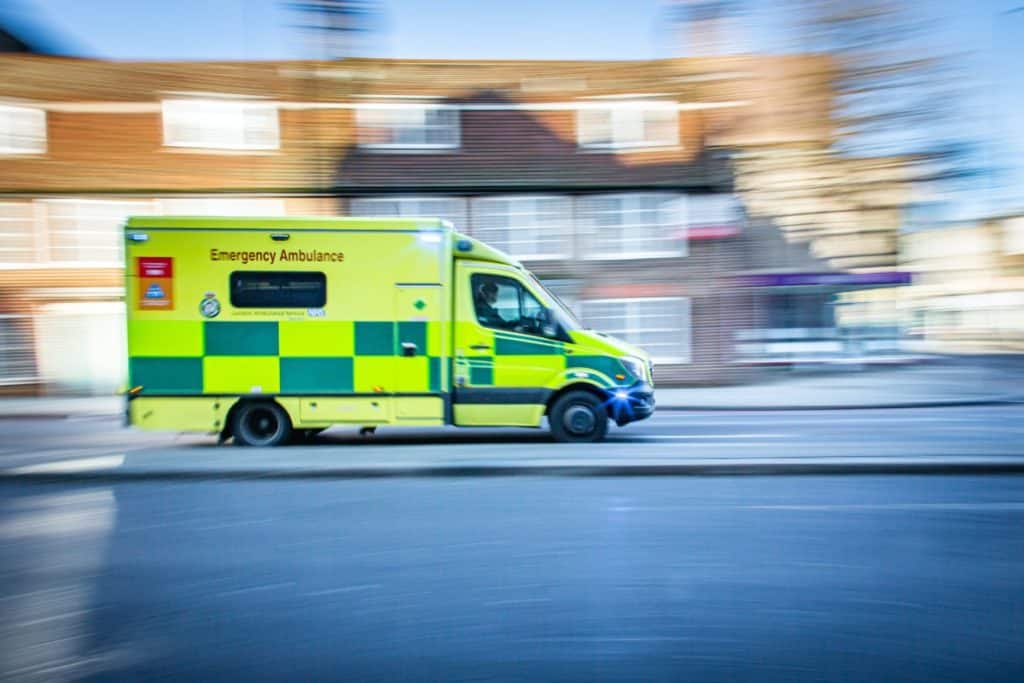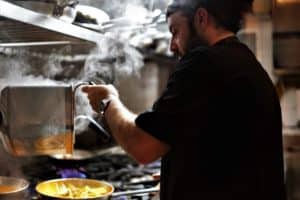Ever wondered how often chefs cut and burn themselves? Working with super sharp knives and incredibly hot pans all day long has got to be a recipe for disaster right?
The truth is, that in reality chefs do not often cut or burn themselves, but when they do the injuries are usually pretty severe. In this post I will share a few personal anecdotes of times I have gotten injured whilst working as a chef and how often I’ve had to go reaching for the first aid box.

In my chef career spanning 10 years, I can remember seriously cutting myself only twice, with around 20 more little nicks and cuts that go pretty unremembered. The knife techniques that we develop as chefs makes cutting ourselves less frequent than one may imagine.
A chefs hands will take a lot of punishment within a working day. As well as having to avoid being on the wrong end of a sharp knife , there are also the hot pans, acidic fruits (lemon juice in a graze anyone?) and the industrial strength washing up liquid that all provide plenty of punishment to our hands throughout the day.
, there are also the hot pans, acidic fruits (lemon juice in a graze anyone?) and the industrial strength washing up liquid that all provide plenty of punishment to our hands throughout the day.
This constant hand punishment makes it difficult to give an accurate number on the amount of little cuts I sustained during my career. A few times a year I would just catch myself with the knife, a little injury that needed no more than a blue plaster and a glove to allow me to carry on!
and a glove to allow me to carry on!
How Often Do Chefs Cut Themselves?
As a chef I cut my self seriously twice over a 10 year career period. Once, when I was cutting tomatoes, and once, when I was slicing potatoes on a mandolin. I’ll briefly talk about these two injuries and what went wrong to cause them.
My aim with this is to give readers an insight that is personal and based on real life events. Obviously, the cuts a chef will receive can be rather random, however, they all tend to share the same common trait – not using the correct technique!
My worse cut, number one:
Whilst cutting tomatoes in half with a little pairing knife, I was placing my fingers over the tomato and slicing through, instead of putting all my fingers behind the blade as I should have been.
This meant that my poor little pinky finger was left exposed to the sharp knife blade as I drew it back through the tomato. My concentration wondered away for a second and I sliced the knife right across the top of the little finger!
Thankfully it didn’t require stitches but the blood flowed heavily.
This leads us on to a point that all chefs will understand; when you cut yourself you have to bandage it up so it is food hygiene safe and then carry on working!
and then carry on working!
It is a real pain then for the rest of the day having to wear a plastic glove over the wound whilst it throbs and we have to keep using our hands to prepare the dishes.
To add insult to injury, unfortunately the amount of work we need to do is not reduced, even though we may have lost half an hour sorting out the injury! It is time we have to make back up.
My worse cut, number two:
Below is a video of a mandolin for those not familiar with the kitchen gadget. A mandolin is used to cut ingredients into thin slices. In my case I was using it to thinly slice potatoes to be used in dauphinoise potatoes.
The user sets the blade depth to the thickness required. We then run the potato up and down the surface with our hand on top, so that the slices fall out the bottom.
Now, we should use the supplied guard to help with this (although in professional kitchens these tend to always go missing!). Failing to find the guard we tend to use a tea towel placed over the top of the potato, the idea being that the towel will protect our hand from the blade if we get too close to it.
these tend to always go missing!). Failing to find the guard we tend to use a tea towel placed over the top of the potato, the idea being that the towel will protect our hand from the blade if we get too close to it.
In my haste and poor judgement, I chose at the time to use neither of these and placed my hand flat on top of the potato, a bad habit adopted by many chefs.
As readers can imagine I got too close to the blade and managed to cut a slice into the palm of my hand; Again plenty of blood ensued.
The biggest problem with these kind of injuries is dressing them in a way that allows us to carry on working. For about a week afterwards I had to put up with a strap across the whole palm of my hand that kept trying to slip and get greasy all day long.
Whilst cuts hurt at the time, it is the long running irritation they cause to the speed at which we can work that is the real heartbreak!
As readers can see from my experience the two serious cuts I can remember are when I wasn’t following correct technique.
The techniques that we develop as chefs allow us to cut very fast whilst keeping our hands well out of the way. This ensures that although cuts are an inevitable part of the job, they are reasonably rare.
that we develop as chefs allow us to cut very fast whilst keeping our hands well out of the way. This ensures that although cuts are an inevitable part of the job, they are reasonably rare.
It is not just the never ending amount of sharp instruments within the kitchen that seem to want to get us. The threat of burns are a real issue. Burns are perhaps more common than cuts and usually with far worse consequences.
How Often Do Chefs Burn Themselves?

Burns are an ever prevalent danger within kitchens. The number of searing pans, hot ovens and boiling sauces coupled with the intense time pressures, and number of bodies packed into a small space, make burns almost inevitable.
During my 10 year chef career I seriously burnt myself twice, with around 5-10 other minor burns. In my experience, burns are often worse than cuts due to the fact that they take longer to heal and the pain is far more intense. Inevitably, there are standardised practices chefs follow to reduce the danger of getting burnt.
As readers can see this is not a huge number of times to burn myself over a career spanning a decade. Once you burn yourself once, it makes you a lot more careful to slow down and take care when the danger is present again.
It should also be pointed out that as a chef our hands develop a higher tolerance for heat. Many a time, my partner at home, has commented on my ‘asbestos hands’ whilst I’ve been handling food straight from the oven.
Whilst this ability to handle hot food comes in handy and is a perk that chefs certainly develop over time, there is a level of heat which is impossible to get accustomed to and the burns that result can be severe.
I will detail the two bad burns I received and can vividly remember so that it gives readers an insight into what we can expect, (and what to be extra careful of) when embarking upon a chef career.
My worse burn, number one:
During a particularly busy evening service I had five pans on the stove tops at once. Not in itself uncommon, however, I did not realise that one of the pans was positioned so that the handle was directly above one of the other gas flames. This made the pan handle red hot.
In my haste, due to the busy service, I grabbed the pan handle with my bare hand. I produced what can only be described as an audible ‘yelp’ as the hot pan handle seared across the palm of my hand. The only solution was to run my hand under cold water , apply burn spray and put a plastic glove on.
, apply burn spray and put a plastic glove on.
This, in the same way as cuts, is the biggest problem with burns. Unless they are severe enough to go to hospital or stop work, we are expected to carry on. For the rest of the service I was required to keep working with my hand throbbing.
The mistake I made was to grab a pan without using a cloth wrapped around my hand. This is a bit of a rookie mistake to make at that early stage in my career! Going forward, whenever I take a pan off the stove top, I now always use a cloth regardless of whether I believe it to be hot or not.
to make at that early stage in my career! Going forward, whenever I take a pan off the stove top, I now always use a cloth regardless of whether I believe it to be hot or not.
Using a cloth is standard practice and becomes such an ingrained habit that if I try to lift a pan off the stove with a bear hand, my body now recoils to prevent me before I even touch it. I guess pain is a great way to ingrain some simple habits!
My worse burn, number two:
The hotel kitchen I worked in, required there to be large stock pots bubbling away on the stoves for days on end.
I worked in, required there to be large stock pots bubbling away on the stoves for days on end.

These large stock pots would be taken down form the stoves at the end of the day and left to cool in the kitchen before being placed in the fridge overnight. As the pots where large and heavy this was a two person job.
After one particularly gruelling shift , I was helping my colleague lift the stock pots from the stove, the same as every other night.
, I was helping my colleague lift the stock pots from the stove, the same as every other night.
Unfortunately, the pot was a little too full and we didn’t place it down onto the floor at an even time. My end went down to quickly and the boiling stock splashed out onto my hand; This hurt to put it mildly!
The real cause of this accident was the procedure we where using. Going forward, the kitchens new policy was to turn the heat off to the stock pots much earlier, so that they could cool considerably before needing to be removed from the stove.
Thankfully, it was the end of the night so I was able to go home afterwards and lick my wounds. However, the real problem is the same as before; we have to carry on working for the next few days with an injury that makes our job difficult.
Is Being A Chef A Dangerous Job?
When entering a kitchen for the first time it can seem daunting and dangerous. I hope that readers can see from these examples that there are definitely dangers that we needed to be wary of.
In my experience, being a chef can be a dangerous job due to the daily use of sharp knives and the constant handling of hot foods and liquids. However, by following standard operating procedures we are able to minimise many of the dangers that are present.
In my opinion, most chef injuries can be traced back to exhausted and over worked chefs making mistakes due to their fatigue .
.
Perhaps as an industry we should look at the conditions in which chefs are expected to work under and see what measures can be brought in to prevent overwork and exhaustion?
It is also worth noting that many kitchens do not provide sickness cover . If a chef is unable to work due to an injury or illness they often choose to ‘soldier on’ as they know they will not be paid if they do not turn up fit for work.
. If a chef is unable to work due to an injury or illness they often choose to ‘soldier on’ as they know they will not be paid if they do not turn up fit for work.
Again this is something that will hopefully improve over time. In my experience the larger employers tend to offer some type of sickness cover, even though it is far below the perks seen in other industries.
For a chef, I would suggest that the odd burn and cut is inevitable. However, by focusing on good technique and standard operating practices early on, we can minimise many of the dangers that occur and have a long and fulfilling chef career.
